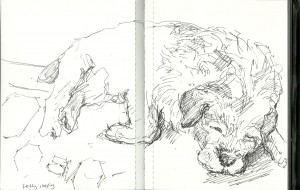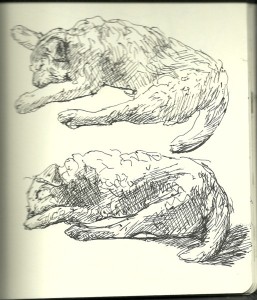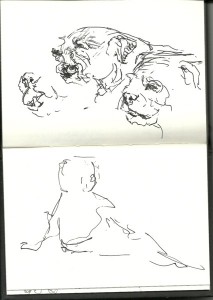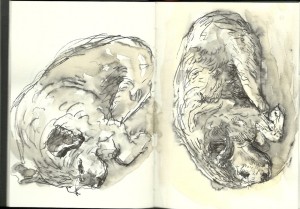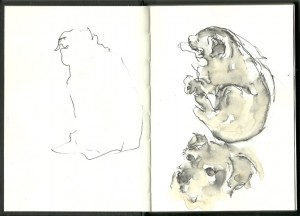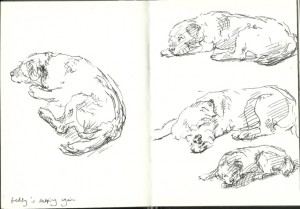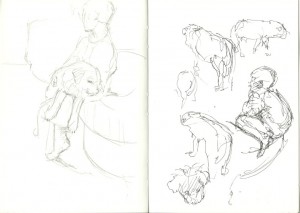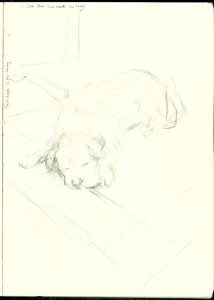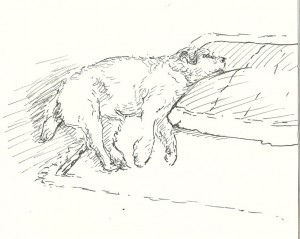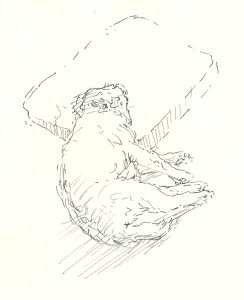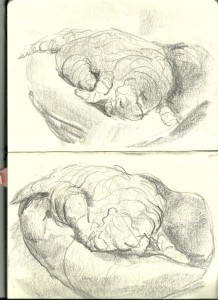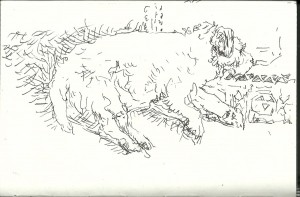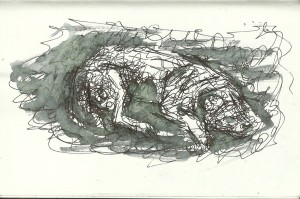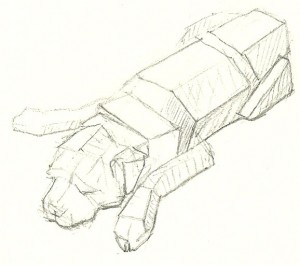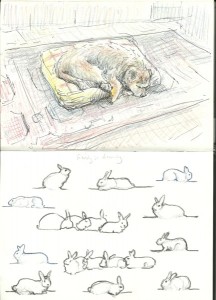Sketchbook dog drawings
May 24, 2012
Ideas and tips for sketching your pet at home
Today I shall share some of the dog drawings from my sketchbooks. This post is in memory of my Border Terrier, Freddy, who recently died at age 17 years.
Here are some suggestions for drawing pets, this time illustrated by sketches of my own dog. These tips are applicable to drawing any animal from life.
A variety of poses per page
Pets make great models, but you never know when they will change position. Be prepared to start more than one drawing on a double-page spread of your sketchbook. It doesn’t matter if one or more of these poses remain unfinished.
In the two sleeping poses above, I had time to build Freddy’s structure up with pen cross-hatching, and also to suggest his shaggy coat with pen strokes.
In the awake poses, below, I have used a more fluid style of line to suggest his posture without any attention to tone or texture.
With a panting dog, consider what can and cannot be seen of the lips, teeth and tongue. In a shaggy Border terrier, the upper teeth and lips are obscured by hair, and we see a little of the lower canines (those are the long teeth) and tongue).
In the sketchbook below, I did a few scribbly drawings of Freddy moving about before he settled down for a sleep. The attempts to draw him in various fleeting postures adds a little character to the pictures of him sleeping.
I made these two resting views into self-enclosed peaceful shapes, one on each opposite page.
Here are three poses as seen almost from above as he changed sleeping position. He had long, shaggy fur over his back that parted in the midline. The shagginess could sometimes make it difficult to understand the actual structure of him and it is important not to fall into the trap of drawing every strand of hair. Sometimes the fur could be useful in my drawings, e.g. to help delineate where the middle of his back was positioned. Here I used the bulk of the fur to suggest his posture:
Sometimes I would embark on what I expected to be a longer drawing of him resting, only for him to move unexpectedly. This can be a blessing in disguise. See how most of these lines are left fluid and dynamic. The small amount of cross-hatching is restricted to one side of his head, and this is just enough to suggest which way the light is falling:
The brief sketch on the left page, below, merely hints at the terrier’s outline. He then moved position, but this was enough to give plenty of information about how he was sitting:
My pen drawings of Freddy were all made very directly, without any erasable under-drawing. Errors can be incorporated into the drawing. Indeed, multiple lines resulting from error can be beneficial, suggesting that the dog is moving or about to move.
What does your pet do?
It is easiest to draw your dog as he or she sleeps, but do try to sketch your pet engaged in their usual day-to-day activity if at all possible. A good place to start is to draw them eating. You will hopefully have at least a minute or two to work:
If your pet tends to sit with a certain person, see if you can sketch them together. Freddy got on particularly well with my little boy, Oliver, who was forever picking him up. Here (on the left-hand page of the sketchbook, below) is Freddy draped comfortably over Oliver’s knee:
Does your dog lie in a funny position? In his old age, Freddy went through a phase of wanting to lie upside-down and would rest like that for a few minutes. This is a challenging pose to draw (watch out for all that foreshortening) and he tended to roll slowly back onto his side so I had to draw rapidly:
The dog in his environment
Do suggest bits of your pet’s surroundings in your pictures. Cats and dogs choose places where they tend to rest in the home. The way in which they sit or lie in these spaces is meaningful and worth recording.
Here is Freddy towards the end of his life. By this stage, he was painful at times and wanted to lie with the left side of his head resting on his bed. He needed human help to get into this position but, once there, he would rest happily.
Here is Freddy surrounded by household mess that the children have left on the floor. He doesn’t mind. There is one of those soft wobbly balance cushions as well as a plastic water bottle. Being both blind and deaf, I think Freddy quite liked to be in contact with objects to give himself a point of reference:
Experimental approaches to drawing
Pets are completely uncritical of our efforts, do not insist that we flatter them, and they do not mind a bit if we try unconventional drawing methods.
For example, here I used a chunky sticky of graphite to build up an image in cross-contour lines. These are lines that appear to curve over and around the form of Freddy and his bed.
This is a line drawing made with a Rotring pen, this time thinking of Freddy as more of a blank empty space and creating his image by building up short lines around him:
This drawing is layered with scribbly pen lines and ink wash. He emerges from the scribble on the page:
And here is the volume simplification drawing that I made of him just a few weeks ago:
A note about sketchbook layout
It is a good idea to change your drawing approach as often as possible within your sketchbook. This ensures that your sketchbook looks interesting to those who take a look through it. Different drawing methods also keep you on the ball as an artist, and ensure that you do not keep repeating the same picture over and again.
From time to time, you can even be a bit whimsical if you wish. In the double page spread, below, I drew Freddy sleeping yet again, but then imagined that he was dreaming of rabbits. He used to love to chase rabbits but never caught one:
The most obvious way to keep your sketchbook interesting is to work in a variety of media…
Remember to check this blog again on Sunday, as I shall be posting about sketching dogs in various media, from pen to pastel.
